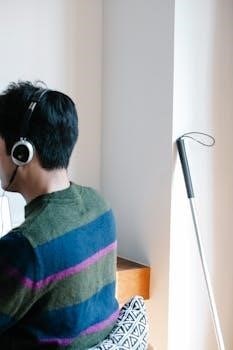Welcome to the comprehensive guide for your JBL Charge 3! This manual will assist you in navigating the features of your portable Bluetooth speaker. Learn about its capabilities, including wireless connectivity, waterproof design, and long-lasting battery. We’ll cover everything you need to know.

What’s in the Box
When you first receive your JBL Charge 3, you’ll find a carefully packaged set of items designed to get you started right away. Inside the box, you’ll discover the JBL Charge 3 portable Bluetooth speaker itself, which is the centerpiece of the package. This speaker is built to deliver high-quality audio and robust performance. You’ll also find a USB cable, which is essential for charging the speaker’s internal battery, allowing you to power up your device quickly and efficiently. In addition to these core components, the package includes a quick start guide. This guide provides essential instructions to help you with initial setup, pairing the speaker with your devices, and understanding the basic functions of the speaker. The guide may also include information about using the JBL Connect feature. Furthermore, the box may contain warranty information, which ensures the product’s quality. Carefully review all the included items to make sure you have everything and to familiarize yourself with the contents before proceeding with the setup process. Make sure you keep the packaging in case you need to return the device. This ensures that you have everything needed for a smooth and enjoyable experience with your new JBL Charge 3 speaker.
Button and Connection Overview
The JBL Charge 3 features a user-friendly design with clearly marked buttons and connection points for ease of use. On the top panel, you’ll find the power button, which is responsible for turning the speaker on and off. This is usually identifiable by a distinct symbol. Adjacent to the power button are the volume controls, allowing you to adjust the sound level according to your preference. The Bluetooth pairing button enables you to connect the speaker to your smartphones, tablets, or other Bluetooth-enabled devices. The JBL Connect button lets you connect multiple JBL speakers for a richer, more immersive audio experience. Moving to the rear of the speaker, you’ll discover the connection ports under a protective cap. These include the micro-USB port, used for charging the speaker and the USB port for charging other devices. There is also an AUX input, which allows you to connect devices using a 3.5mm audio cable. These physical buttons and connections are vital for controlling the device and connecting it to different audio sources or charging it. It’s important to understand each button and connection to optimize the speaker’s functionality and ensure a seamless user experience. Make sure the protective cap is tightly closed to ensure the waterproof capabilities of the speaker.
Bluetooth Pairing Instructions
To initiate the Bluetooth pairing process with your JBL Charge 3, begin by ensuring that your speaker is powered on. Once on, locate the Bluetooth button, which is typically marked with a Bluetooth symbol, usually on the top of the speaker. Press and hold this button for a few seconds until you hear an audible tone or see the LED indicator start flashing. This indicates that your speaker is now in pairing mode, ready to connect with your device. Next, navigate to the Bluetooth settings on your smartphone, tablet, or other Bluetooth-enabled device. Look for available devices, and you should see “JBL Charge 3” appear in the list. Select it to initiate the pairing process. Once the pairing is complete, your device will confirm the connection, usually with another tone or message on your device and the speaker’s LED will become solid. You can now start playing audio wirelessly through your speaker. If the pairing fails, repeat the process again. Remember that the JBL Charge 3 can connect to multiple devices, but only one can play music at a time. Make sure the device you want to use is connected and selected.
JBL Connect Feature

The JBL Connect feature allows you to amplify your audio experience by wirelessly linking multiple JBL Connect-compatible speakers together. To begin using this feature, first ensure that all of the speakers you intend to connect are also JBL Connect-enabled. Power on all of the speakers you want to connect to your main device. Then, locate the JBL Connect button on each speaker, usually marked with a unique symbol. Press this button on each of the speakers. Once you have pressed the button on all the speakers, give them a few moments to synchronize. The speakers will automatically detect each other and establish a connection. You’ll hear an audible tone when they’re successfully linked. Once connected, the speakers will play the same audio simultaneously, creating a richer, more immersive listening environment. It’s a great way to expand your audio coverage in a larger space or add more powerful sound for a party. You can connect up to a certain number of speakers with JBL Connect, allowing for a fully synchronized multi-speaker experience. To disconnect, simply press the JBL Connect button on any of the speakers. Remember that the audio will be played from the same source. Enjoy the multi-speaker audio experience with JBL Connect.
Waterproof Capabilities
The JBL Charge 3 is designed with a waterproof feature, making it suitable for use near water sources, like pools or beaches, without fear of damage from splashes or rain. However, it is crucial to understand the specific limitations of this feature. The JBL Charge 3 is not designed for submersion in deep water or for extended periods of immersion. Prior to exposing your speaker to any liquids, it is vital to ensure that all cable connections are disconnected and that the protective cap is tightly closed. This will prevent water from entering the internal components and causing damage. Exposing the speaker to liquids without taking these precautions may cause permanent and irreparable damage to the device. Additionally, never expose the JBL Charge 3 to water while it is actively being charged. Doing so creates the risk of electrical damage and poses a safety hazard. Remember that the waterproof rating only applies when the speaker’s ports are properly sealed. Regularly inspect the port covers and ensure they are not damaged or worn. By taking these steps, you can fully enjoy the waterproof capabilities of your JBL Charge 3 speaker without risk of harm. Always be responsible and take necessary precautions when using it near liquids.
Charging the Speaker
To charge your JBL Charge 3, locate the charging port, which is usually covered by a protective flap. Open this flap carefully. Connect the provided USB cable to the port on the speaker and to a compatible power source, such as a USB adapter or computer. Ensure that the power source is functioning properly. The charging process will begin automatically when the connection is established, and an indicator light will illuminate to signify that the speaker is charging. The JBL Charge 3 requires approximately 4.5 hours for a full charge. During charging, it is advisable to keep the speaker away from areas where it may be exposed to excessive heat or moisture. Do not use the speaker while it is charging, as this can affect the charging time and may generate excess heat. Once the battery is fully charged, the indicator light will change or turn off. Disconnect the charging cable from both the speaker and the power source. Overcharging the speaker is not recommended. For optimal battery life, charge the JBL Charge 3 only when necessary. Always use the original cable provided with the device, or a cable that is specifically designed for the purpose. Using incompatible charging cables may cause damage to the device.
Battery Life and Playtime
The JBL Charge 3 boasts a robust rechargeable li-ion battery designed to deliver extended playtime. On a full charge, you can expect up to 20 hours of continuous music playback, allowing you to enjoy your favorite tunes throughout the day or during long events. Keep in mind that actual playtime may vary depending on the volume level, the type of music being played, and the use of additional features. Higher volume levels and bass-heavy music tend to consume battery power more rapidly; The JBL Charge 3 also features the capability to charge other devices via its USB output port. This convenient feature, while extremely useful, will impact the speaker’s own battery life and playtime. Therefore, using the speaker to charge your smartphone or tablet will reduce the time you can use the speaker for music playback. When the battery level is low, the speaker will usually provide an audio prompt or visual indication, giving you time to connect to a power source. To maximize battery life, avoid exposing the speaker to extreme temperatures. It is always best to fully charge the speaker before using it for extended periods.

Using as a Speakerphone
The JBL Charge 3 is not just a powerful speaker; it also features a built-in microphone, allowing you to use it as a speakerphone for hands-free calls. When a call comes in while your phone is connected via Bluetooth, simply press the call button on the speaker to answer. The speaker uses noise and echo-canceling technology to ensure clear conversations. This feature helps to minimize background noise and reduce echoes, making your voice easier to hear for the person on the other end. For optimal speakerphone performance, speak directly towards the speaker, maintaining a reasonable distance to allow the microphone to pick up your voice clearly. During a call, you can use the speaker’s volume buttons to adjust the call volume. When you’re finished with the call, press the call button again to end it. You can also use the speaker to access your phone’s voice assistant, making it convenient to make calls or control other functions on your device. The hands-free speakerphone feature adds another level of versatility to the JBL Charge 3, making it a useful companion for both music and communication.
Troubleshooting Common Issues
If you encounter issues with your JBL Charge 3, here are some troubleshooting steps. If your speaker won’t power on, ensure it’s charged by connecting it to a power source using the provided USB cable for at least 30 minutes. If Bluetooth pairing fails, confirm that Bluetooth is enabled on your device, and try restarting both the speaker and your device. Make sure the speaker is not connected to another device that might be interfering with the pairing process. If your speaker is not producing sound, ensure the volume is turned up on both the speaker and your device, and also check that the correct audio output is selected on your connected device. If the sound is distorted, try lowering the volume and make sure the speaker is not near any objects that might be causing interference. If the speaker is not charging, try using a different USB cable and power adapter. If these steps fail, consider resetting your speaker to factory settings by pressing and holding the Bluetooth and volume up buttons for a few seconds. Always make sure to close the cap tightly to protect it from water damage. If issues persist, check online resources or contact customer support.
Safety Precautions
To ensure the safe and proper use of your JBL Charge 3, please observe these safety precautions. Always ensure the charging port cap is tightly closed before exposing the speaker to water, as failing to do so may result in permanent damage. Do not expose the speaker to water while charging, as this can lead to electrical hazards. Avoid using the speaker in extremely high or low temperatures, as this may affect its performance and battery life. Refrain from disassembling or modifying the speaker, as this can cause irreparable damage and void the warranty. Do not use any third party or damaged charging cables, always use the original one supplied with the device. Keep the speaker away from open flames, heaters or other sources of heat. Avoid dropping or exposing the speaker to heavy impacts, which can damage the internal components. Clean the speaker with a soft, dry cloth; do not use abrasive cleaners or solvents. Always listen to music at a safe volume level to avoid hearing damage. Keep the speaker out of reach of young children to prevent accidental injury. If you notice any unusual smells or overheating, disconnect the speaker and contact customer support. By following these guidelines, you can enjoy your JBL Charge 3 safely for years to come.
Available Manuals and Documents
To further assist you in understanding and utilizing all the features of your JBL Charge 3, several manuals and documents are available. The primary resource is the Quick Start Guide, which provides a concise overview of the speaker’s functions and basic operation. This guide is included in the box. For more in-depth information, the complete User Manual can be downloaded in PDF format. This manual covers all aspects of the speaker, including detailed instructions on pairing, using JBL Connect, and troubleshooting. Additionally, you may find a Service Manual, which is a technical document for more advanced users or for repair purposes. These documents can be found on the official JBL website under the support section. Ensure you are downloading the correct manual for the JBL Charge 3 model. These resources provide detailed instructions, illustrations, and explanations to help you fully enjoy your speaker. Always refer to these documents for the most up-to-date information. Various language options are usually available for these manuals. Keeping these documents handy ensures you have all the information you need at your fingertips.

